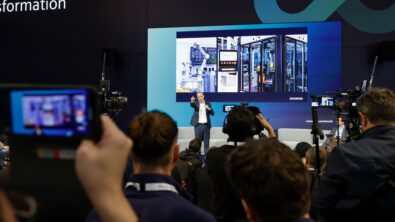Advanced robotics requires advanced programming
Tecnomatix 12 is coming soon and it will offer new functionality for programming the latest advanced robotics.
http://youtu.be/sbV5aR05Pp0
Even if you don’t closely follow the world of advanced robotics, you’re probably aware of the debate about what the growing use of robots means for humans and human jobs.
While there are those who predict that eventually, the majority of us will be replaced by robots as they take on all kinds of white collar tasks, we at Siemens side with those who believe that advanced robotics creates jobs.
The NY Times article, “Robot Makers Spread Global Gospel of Automation,” summarizes the job creation side’s argument nicely: “While automation may transform the work force and eliminate certain jobs, it also creates new kinds of jobs that are generally better paying and that require higher-skilled workers.” The article cites an International Federation of Robotics study that indicates that the robotics industry will “directly and indirectly create between 1.9 million to 3.5 million jobs globally by 2020.”
In terms of job growth here in the US, the effect of robots can be equally positive, in the sense that it can make US manufacturers more cost-competitive. According to Matt Tyler, president and CEO of Michigan-based contract manufacturer Vicker’s, his company has been better able to compete globally since deploying advanced robotics solutions, winning jobs it might have lost in the past to competitors in lower wage countries. Vickers has actually added employees since introducing the robots, Tyler noted.
As a supplier of software that’s used for robot simulation and programming, Siemens PLM Software has been helping companies deploy advanced robotics systems for many years. Our Process Simulate Robotics software and RobotExpert software are used every day around the world to program, simulate, and virtually commission robotic processes. Our solutions have a strong presence on automotive body-in-white (BIW) assembly lines, heavy equipment welding and edge profiling, jet engine and turbine surface treatment and are also well suited to manufacturing line and cell automation, as well as high tech electronics manufacturing – a relatively new application for robots.
As you might imagine, robot simulation and programming software is always evolving. Our job as a supplier of this software is to make sure we keep pace with the advances in the robots themselves, which have been dramatic in recent years.
One of the ways we are extending Siemens’ leadership position in robotics programming and simulation is by making sure that Tecnomatix software supports the latest developments in advanced robotics functionality. You will see examples of this in the new release of Tecnomatix (Tecnomatix 12), which has functionality for programming and simulating dual-arm and cooperative robots. These new advanced robotics are important because they open up new markets for robot use, such as the assembly of products like mobile phones, most of which has previously been limited to humans.
We are also changing how advanced robots are programmed. With Tecnomatix 12 software, engineers can easily work together to program single-robot stations, work cells, production lines and zones by using event-based simulation software connected to the data-managed environment, Teamcenter. The data management aspect enhances communication and coordinate among manufacturing disciplines, and enables engineers to re-use, author, validate and optimize sophisticated automation systems faster and with fewer errors.
http://youtu.be/mKLVa9S3S9k
This video is an example of automatic path planning where the robot adapts its path in reaction to obstacles.
In the realm of research, an important technological development area involves integrated robot vision. Rather than being an add-on, vision functionality is now being built in to many advanced robotics solutions, allowing robots to perform more complex functions such as determining the position and orientation of objects, and adapting their paths in reaction to obstacles. (This latter functionality is expected to bring about a huge change in how and where robots can be used in manufacturing environments. Older robots have always been installed behind glass walls or wire cages to prevent them from harming humans. Robots with reactive path planning capabilities can work right next to humans because they can change course or shut down when they detect that someone is nearby.)
Another example is Siemens PLM Software’s purchase of Kineo CAM and the incorporation of Kineo automatic path planning and collision detection functionality into a range of our solutions, such as NX, Teamcenter, and of course, Tecnomatix. Kineo technology is already used by more than 200 companies worldwide; an estimated 90% of leading automotive OEMs use Kineo. For Tecnomatix, Kineo technology can provide the ability to plan and optimize collision free robotic programs and assembly path in matter of seconds.
Companies have long relied on Tecnomatix robot simulation and programming solutions to speed to market, increase throughput, optimize cycle times, and reduce the number of physical prototypes they need, to name just some of the benefits. The new capabilities in Tecnomatix 12 ensure that they can continue to reap these benefits, even as the functionality of their robots advances by leaps and bounds.
Additional notes:
Tecnomatix 12 is coming soon, November 2014, so stay tuned as more information will become available. Follow these links for additional information and to download a free trial to try for yourself.


